Table of Contents:
- Introduction
- Who is Alex Koyfman?
- The Power Behind the Power
- Big Enough to Change the World We Live In
- The Biggest Investment Opportunity Of the 21st Century
- It's Trading Publicly Right NOW!
- Electrified Profits: From Startup to Trillion-Dollar Industry Giant
- Tesla 2.0: The Government-Mandated $7.5 Billion EV Revolution
- Penny Stock Quick-Start Guide
- It's easy to do…
How Did a Tiny $20 Million Startup Make Tesla’s Entire Product Line Obsolete?
Tesla Is Now the Most Successful Electric Vehicle Manufacturer in the World
But in Less Than Three Years’ Time, Its Cars Will Be out of Date…
And It’s All Because of This Device:
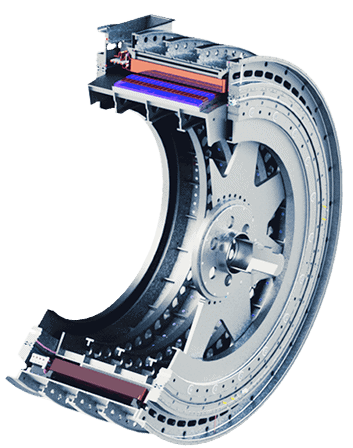

On August 11, 2020, Tesla Motors (NASDAQ: TSLA) shocked the world.
It wasn't the announcement of a crazy new model or a new range or speed record.
Instead, management delivered a jaw-dropper of a different kind when it announced a 5-to-1 stock split in an attempt to bolster a market capitalization that already exceeded $700 billion — or 4½ times that of the next biggest car company in the world, Toyota.
The pundits doubted and scoffed, but within six months, the effect had been felt.
Tesla share were up another 60%, putting the EV-maker into the trillion-dollar club for the first time.
It was a great moment to be a Tesla shareholder and, in my view, a great day for the American automotive industry, which needed this shot in the arm badly.
Unfortunately, this victory is destined to be a temporary one, as a problem much bigger than profit margins is now hanging over Tesla like an approaching hurricane.
You see, at the core of every Tesla car lies a fatal flaw.
It's not the fault of the engineers. It's not the fault of Elon Musk. It's not the fault of the electric car industry.
This fatal flaw is much bigger and farther reaching than Tesla itself. It affects billions of devices around the world, from tiny ones like the phone in your pocket to the electric watch on your wrist and all the way up to oil tankers weighing in at half a million tons.
That flaw is the electric motor.
You see, since they were first invented back in the 19th century by British scientist Michael Faraday, electric motors have had a weakness built into them.
Incredibly, that weakness has never been addressed.
I suppose Michael Faraday figured his invention would quickly evolve to defeat this problem, but in the nearly 200 years since, nobody's been able to come up with a solution.
It wasn't until a tiny tech startup headquartered in Vancouver finally made a crucial breakthrough that this problem was finally solved.
Once its revolutionary new motor was perfected, every existing electric motor became a relic — including every motor Tesla has ever built and installed.
In the next few minutes, I'm going to tell you all about this company. I'll tell you about the brilliant minds behind the breakthrough, and I'll explain to you what this innovation will mean for global industries ranging from power generation to consumer electronics.
I'll even show you how this previously unknown company's stock is already starting to respond as news of its discovery slowly leaks to the mainstream media.
But first, I want to explain to you just how big this problem is and how it affects all of us… you and me included.
It's the Most Important Mechanical Device in Human History… And It Doesn't Work Right
Did you know that a full half of all the energy produced globally is consumed by electric motors?
That's over $3 trillion worth of electricity, or 5% of the total global economy, spent on a simple process where current running through a magnetic field is transformed into rotational force.
Electric motors come in all shapes and sizes. They range from some of the smallest machines ever built to giant engines capable of propelling a ship 10 times as massive as the Titanic.
That's an incredible amount of energy, worth more than the entire gross domestic product (GDP) of the UK, all committed to the same exact process.
Shocking, right? Well, that's how important electric motors are to us. They're everywhere. They make everything work. And they've been doing it for almost 200 years.
Now, you'd think that after two centuries of nonstop development, there would have been a number of major technical innovations.
But here's the surprising truth: Electric motors haven't seen a single fundamental evolution since their very advent.
Almost as Basic as the Wheel Itself…
It's been made bigger. It's been made of different materials. It's been standardized and perfected with modern manufacturing processes.
But in all those 200 years, nobody's made any real changes to the basic motor.
The electric motor today is what it was when horses were mankind's main mode of transportation: a single copper wire wound around a spool within a cylinder that contains magnets.

And that means even the high-tech motors Elon Musk puts into every Tesla vehicle to hit the road are nothing more than antiques dressed up with modern finishes.
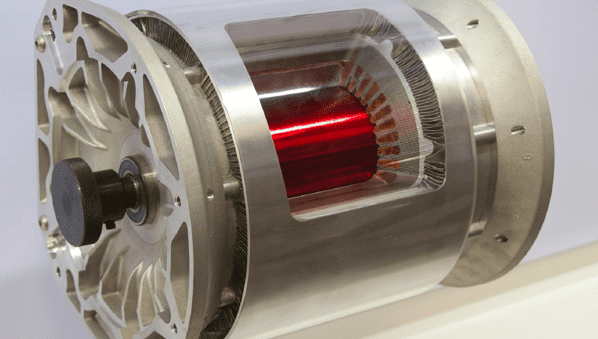
Well, all that is about to change.
And if the size of the electric motor market or the fact that it hasn't been changed since long before the gas engine was even invented shocks you, get ready to be shocked again…
Because the company that's already marketing a new, more efficient electric motor design isn't some industrial giant like General Electric (NYSE: GE), a carmaker like Ford (NYSE: F), or even some tech-crazed dot-com empire like Google (NASDAQ: GOOG)…
This innovator, which now controls patents to the first true evolution of the electric motor, is a true-to-life technology startup with a total market capitalization of less than $20 million.
A Corporate David-and-Goliath Story Is Unfolding as You Read This
The motors it's building today have efficiency ratings that beat everything out there.
And that means not only will the new generation of motors use less energy, but they'll also be smaller, cost less to maintain, and last longer.
All that means a huge advantage to anything that uses electric motors to work.
But it also means an even bigger advantage for another major industry: power generation.
After all, power generators are just electric motors working in reverse.
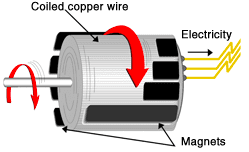
Instead of putting electricity in to make the shaft spin, you spin the shaft and power comes out.
It's the same for every generator out there, from the modern wind turbines dotting the hills of San Bernardino County to the oldest steam-driven generators going back to the 19th century.

The principle behind them all is the same. The only alternative means of creating electricity is through solar cells.
Which means 99% of all the power we produce globally comes out of one basic mechanism: the generator.
That makes the following revelation all the more important.
You see, a few weeks ago, I got a phone call from the CEO of this company.
“We're About to Change the World…
Wanna Join Us?”
Now, I'm no newbie to the game of salesmanship, so I was hesitant to believe the scope of this thing at first.
But after the 30-minute conversation was over, I knew I would never view the world the same way again.
It was like I'd spoken to Thomas Edison himself and heard his plans months before the rest of the world had any idea what was happening.
But the alarming fact of the matter is that it's happening now, and it's happening fast.
This company's product is already entering the market.
It's already signed licensing deals to put this technology into a wide array of commercial products.
When the call was over, I caught my breath and immediately got down to writing a research report on this company because one thing was clear: If I didn't, somebody else would beat me to it.
And I'd lose the opportunity of a lifetime: to tell my readers about one of the most important technical achievements since before the American Civil War.
I recently completed that report, and it's now ready to be released to the public for the first time ever.
I'm just about ready to show you that report.
When you open it, you'll see the company's name and its ticker symbol, and you'll get the opportunity to see how the stock has been moving over the last few weeks.
Before I give you access, though, I want to explain how it outsmarted every name in the business, including multibillion-dollar giants.
The Power Behind the Power
Like I said before, it's so simple that a child could build one. Yet it's gone without any major changes since the very start.
Wind a copper wire around a spool, place it inside a magnetic field, put an electric current through it, and magic will happen: the spool will begin to turn.
This basic idea has found its way into billions of devices since Michael Faraday proved the concept back in 1821.
Electric motors have been built to move the biggest machines in history and also provide power and control to some of the tiniest ever conceived.
They're precise enough to move robots with natural flow and precision. And they're strong enough to bore train-sized tunnels through solid rock.
So why haven't they seen any major improvements over the almost two centuries of constant use and development?
The answer is simple…
The mechanism behind the motors has stayed the same. But their power and size has been changed and evolved constantly through the implementation of advanced materials and production methods.
Just like the internal combustion engine (ICE), which has seen its share of add-ons and improvements through the use of lightweight materials that are more durable like advanced alloys and ceramics, electric motors have benefited from improvements in the materials used to build them.
But the mechanism itself — and unfortunately, the inherent weaknesses of that mechanism — has remained the same.
Until now…
It took a stroke of genius and the work of a barely known, development-stage company to finally make a quantum leap in electric motor design.
Within the next few years, this technology will replace everything that's come before it.
And you'd better believe that some of the biggest names in the business are starting to worry…
It's Like Comparing a 10-Speed Racing Bike to a Tricycle
So how will this tiny company that I told you about earlier turn the electric motor industry upside down?
What will it do differently that nobody else has done before?
Well, to understand this, you'll need to understand the chief flaw in every electric motor built between the 1820s and today: efficiency.
You see, existing electric motors achieve peak efficiency at a single operating speed.
Above and below that speed, efficiency begins a substantial drop-off.
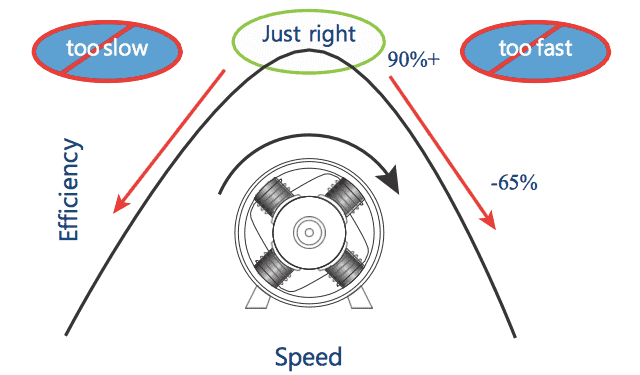
Or to put it a bit more scientifically…
Electric generators and motors work at peak efficiency in a narrow speed and torque range. And that limits their abilities to convert energy or produce electricity efficiently as speed varies.
This results in great energy losses in all applications, most notably: Wind power generation, electric cars and mass transit vehicles, run-of-river generation, mining operations, etc…
It's actually pretty easy to understand if you compare it to a bicycle.
To get maximum usability, modern bicycles have several gears to allow you to use your leg muscles most efficiently as you go faster or slower, uphill or downhill.
Electric motors never had this sort of internal mechanism.
It was always just a single spool of wire that carried a single voltage.
What this company did, that no company before it has ever been able to do, is build a gearing system into the spool itself.
Only, it's not mechanical like the kind you'd find on a bike or inside the gearbox of your car.
It's done using complex, highly sophisticated algorithms to optimize power electronics and efficiency at all speeds.
The system is called “dynamic power management” (DPM). And today, it's giving the same kind of advantage to a whole new generation of electric motors and generators.
It's the same kind of advantage that a 10-speed bike would have over a primitive bike from the 1800s or a child's tricycle:

It's that simple and that dramatic of an improvement.
It's maximum efficiency at any speed.
And it's a single invention that within the next five–10 years will make every existing electric motor and power generator obsolete.
The benefits across the board will be staggering.
We're looking at billions of dollars less energy used in powering this new generation of motors.
Your electric car will have potentially hundreds of miles of added range. Diesel-electric trains will be able to run twice as far, or carry twice as much payload, using the same amount of fuel.
And when looking at the benefit to power generation, the difference will be even greater.
Every wind turbine, every hydroelectric dam, every nuclear and coal plant retrofitted with DPM will see huge gains in power generation. And that will amount to tens of billions of dollars in added production without having to build a single new unit.
That alone will be more than enough of an incentive for major corporations like Tesla, Mercedes, BMW, General Electric, Honeywell, and a host of other multibillion-dollar giants to switch over to DPM systems.
But this isn't the end of it — not by a long shot.
The benefits of DPM technology will also…
Reduce size, cost, and weight by maintaining a tighter voltage range. And it'll prevent catastrophic failures by isolating faulted coils through dynamic power electronics control.
That's a major step forward all by itself. And it's because catastrophic equipment failures have played a large role in blocking faster adoption of electric vehicles (EVs) and renewable power generation by mainstream consumers.
You may have seen pictures in the news of Teslas exploding and wind turbines catching fire:

These are scary sights. And the chance of this happening has kept plenty of potential customers from entering the market.
DPM will be able to cut or completely wipe out these losses virtually overnight…
Big Enough to Change the World We Live In
It's hard to illustrate just how massive of a change this technology will bring.
And it's because almost every modern device that we touch either relies on electric motors or is powered by the electricity produced by electric generators.
Remember, over 50% of all electricity created on planet Earth is consumed by electric motors in their various forms.
And 99% of the electricity we use is created by using power generators, as opposed to solar panels.
The applications are too varied to even begin to list. But they include both the most common and biggest varieties of machines out there.
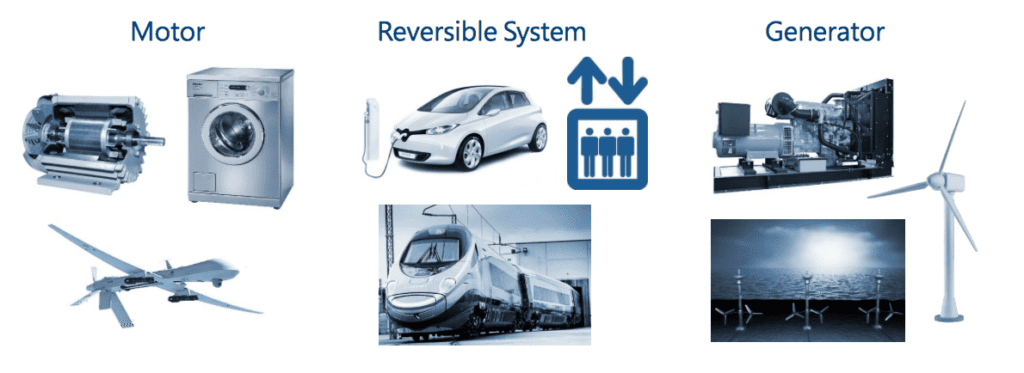
That's how big of an impact dynamic power management technology will have.
All in all, we're looking at tens of billions of dollars in benefit to the global economy within the first few years that this technology is adopted on a mass scale.
Over the course of decades, that figure will run into the hundreds of billions of dollars. And it'll eventually run into the trillions of dollars as it becomes the industry standard the world over.
And I'm not talking in theoretical terms, either.
As you're reading this presentation, the switch to DPM is already underway…
The First 3 Dominoes Have Already Fallen
World-changing innovations tend to take hold quickly. And this company has already taken the first three steps.
This past spring, the company inked a partnership deal with a major North American electric motor and generator producer.
The partner is a heavy hitter that manufactures motors and generators for a wide variety of industrial and commercial applications.
This collaboration will give our tiny company the ability to spread its technology into sectors that usually take years and billions of dollars in capital investment to even touch.
Three existing product lines will be getting retrofitted with our company's dynamic power management technology, each representing a significant foothold in a multibillion-dollar market…
Car Conversion Kit

The first focus will be on electric motors that the partner company currently manufactures for its car conversion kits.
The conversion kit allows for a gas motor of an economy-sized car, the most prevalent car type in the world, to be swapped out and replaced with an electric motor.
The partner is currently introducing its car conversion kit to a sizable market of car owners who want the lower operating costs and the zero-emissions benefits of an electric car without having to replace the whole vehicle.
Within a few years' time, there could be more of these on the road than Teslas. And they'll be accessible to people who don't have $40,000 to $70,000 to plunk down on a new car…
Small Wind Turbine

The second focus will be on small wind turbines.
This is where the parties will collaborate by integrating proprietary dynamic power management technology into a 5-kilowatt (kW) generator.
By reconfiguring the coils within the generator and adding DPM technology, the two companies will produce a voltage that's more consistent under varying wind conditions. And that will lead to better system management and consistent energy production, which is key when you're producing energy for sale on the open market.
It'll allow these wind turbines to outclass the competition, which will clear a path for licensing agreements with additional manufacturers across the globe…
Trams, Trains, and High-Speed Trains

The third focus is on electric trams and high-speed trains.
The partner company currently sells electric motors for each of these markets throughout the world.
The parties will collaborate by integrating dynamic power management technology into motors for each of these respective markets.
Like the car converter kit application where existing limitations of a motor need a trade-off between speed and torque, DPM technology will give these large powerful motors a greater range of efficiency. And that will reduce operational strain on the motor, provide greater energy efficiency, and allow for better selection of motor sizing.
As is the case with wind turbines, success in this field will open the door to more partnerships with even larger partners in Europe and Asia — the world's biggest mass transit markets.
I can't overstate the importance of this landmark partnership, not only for the company but also for the spread of this technology.
It's not just one step toward mass commercialization, but three. Each carries enough importance to propel DPM technology into mainstream use — and launch the company that owns the patents orders of magnitude higher in market capitalization.
Now, although this is definitely great news for the company and for existing shareholders, it does pose a problem for prospective investors…
Because time is now desperately short.
This thing could take off at any time. And when it does, there will be simply no going back.
Once the ascent begins, it'll be hard to tell how far or how high it will continue.
But to give you a ballpark idea of the potential, I've located a few examples from recent history that mirror the path that this company is already on…
It's Likely That We're Looking at the Biggest
Investment Opportunity Of the 21st Century
Let me start by asking you this…
What do you think this company's stock will look like once this technology starts getting integrated on a mass scale?
Where do you think the value of this company will go once the products and licensing deals, like the kind this company has already entered into, start to hit the mainstream?
Well, here's another look at what's already happening:
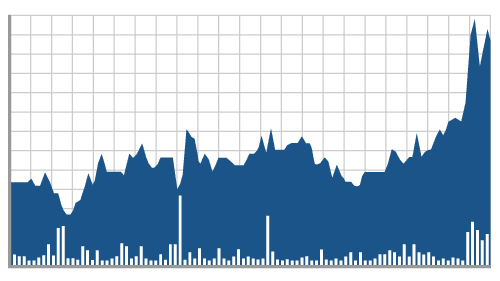
As you can see, the last few months of this company's life have already started to hint at what sort of future is in store.
Investors who bought in earlier this year have already seen their stakes almost double. And that was thanks, in large part, to the collaboration deal the company signed back in the spring.
Now, for most investors, a 100% gain inside of a year would be a home run.
It would be a cause for celebration.
But not in this case…
Because we're still at the very, very beginning stages of dynamic power management technology.
Once it gets going, there's no telling what could happen to this stock.
Although there have been a few examples of what happens when a single company brings out a highly disruptive product.
Back in 2001, Apple (NASDAQ: AAPL) introduced the world's first iPod into the market, a product that would forever change the music industry:
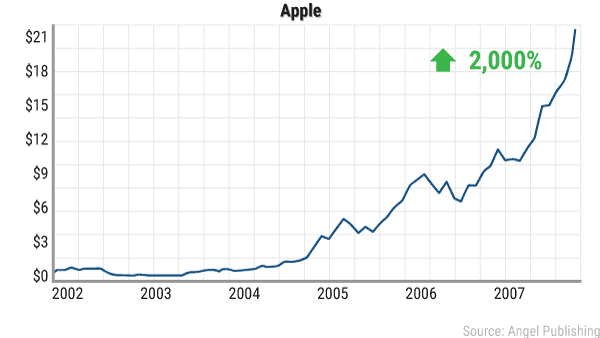
Over the next six years, the company would grow 20-fold. That's even though it was already well past $6 billion in total market capitalization when the new product hit the market.
Just imagine the sort of percentage gains an investor would have made had Apple been worth less than $1 billion when this innovation was first introduced… or less than $100 million… or as is the case with the company that I've been talking about, less than $20 million…
And then there's Netflix (NASDAQ: NFLX).
You might remember when Netflix did business by renting out DVDs through the mail.
But sometime after 2010 when it switched over to a primarily online model, its value skyrocketed.
Here's what it looked like when it disrupted the cable and network television industries:
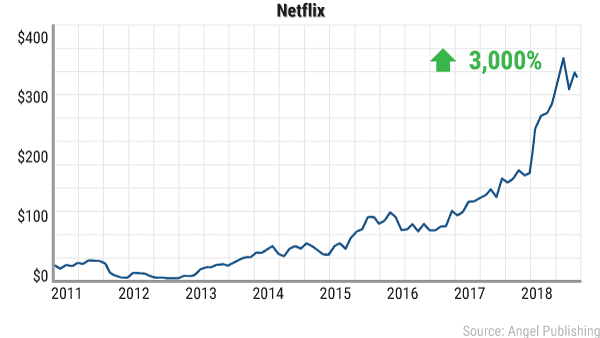
Its market capitalization, also already past the 10-figure mark, exploded by more than 30-fold.
Now, think about the sort of fortune you'd be sitting on had you managed to buy shares of Netflix when it was still a tiny private startup — valued at one-fiftieth of where it was when this historic run-up took hold…
You'd probably be too busy sunbathing on a yacht to be reading this presentation today.
Another example of a company that took disruption to the public markets is eBay (NASDAQ: EBAY).
It debuted during the height of the dot-com boom. And it brought the private seller into the biggest public forum ever.
As the internet exploded, so did eBay's stock. It gained more than 3,000% within only a few short years:
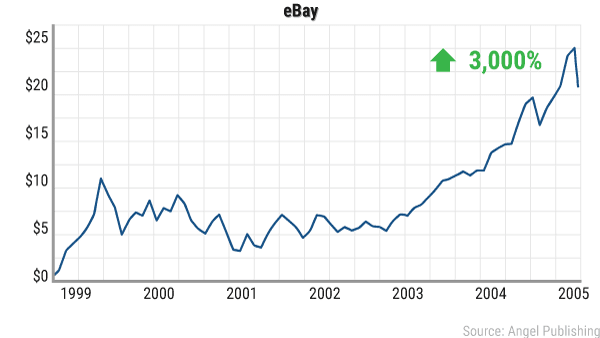
But those who'd invested years earlier, when it was a privately held internet startup, walked away with thousands of times their money.
Now, here's the mother of all disruptors…
We all know it well. But what few people may remember is that within the first two years of its public existence, Amazon (NASDAQ: AMZN), which back then was little more than an online bookstore, rose by an astounding 5,300% as it drove a knife into the likes of Borders and Barnes & Noble:
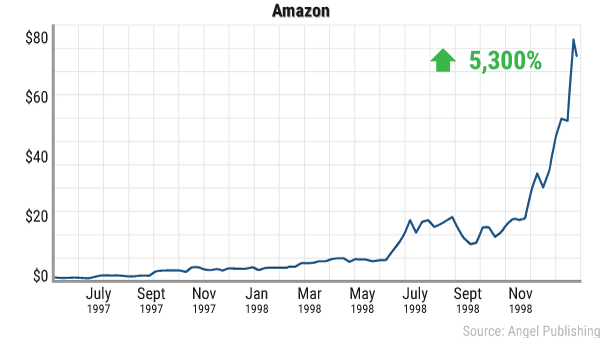
But Amazon wasn't satisfied with just selling books…
The company then took its business model and expanded it to cover just about all consumer goods. It disrupted retail sales across the board and effectively swallowed up an entire sector.
That initial first bit of success, a “mere” 53-fold growth, looks like a blip on the radar as the company continued to grow and grow and grow, by another 25-fold, into the trillion-dollar market capitalization territory. It's now the second-biggest tech brand in the world. And its founder, Jeff Bezos, is the richest man alive:
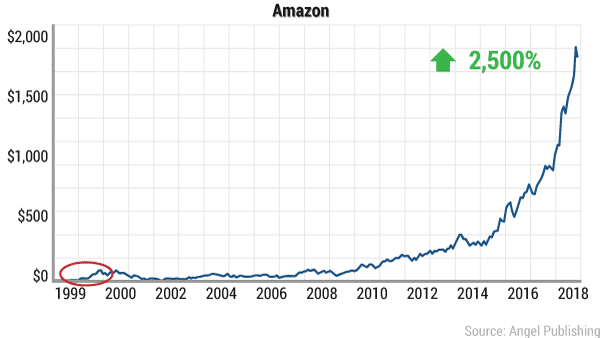
Incredible gains, right? If you'd invested $1,000 into Amazon when it went public with a $400 million valuation, your position would be worth $2.5 million today.
But what if you'd somehow managed to get the stock even before the initial price offering (IPO)… Say, when the company was worth only $20 million?
Well, that meager $1,000 roll of the dice would be worth a mind-blowing $50 million at today's stock prices…
$50 MILLION! That's more than the net worth of most Academy Award winners…
All from a $1,000 initial investment.
So, you might ask… What do these giant successes of the tech industry have to do with the company that I've been talking about since the start of this presentation?
Well, they all show, and quite dramatically, what happens when a company has a single idea that sweeps away everything that came before it.
But because the investment home runs that these examples illustrate all took place at far higher initial market capitalizations, even these historic success stories are conservative to what we could be looking at today.
As I mentioned before, Amazon IPO'd at $400 million. That's more than 20 times the amount of what my recent discovery is trading at today.
But the company that's on the verge of toppling the electric motor and power generation industry is already public.
There's no need to wait for an IPO, because it's a done deal.
You can buy shares today — right now, in fact — from the comfort of your computer.
All you'll need is a trading account on any commonly used platform like TD Ameritrade or E-Trade.
But this as-of-yet unknown company stands to take down an industry worth trillions of dollars. And that makes its true growth potential, over the course of five–10 years, almost incalculable.
I work in a cut-and-dried industry, so I hate making big claims. But with this, there's no other way to go about it.
This is the first and probably the only time in my entire career that I can legitimately say this company should see a 1,000-fold gain within the next five–10 years.
It sounds crazy. But in fact, this estimate is still highly conservative. And that's because the sector it's gunning for, even with licensing value, is worth hundreds of billions of dollars.
Just imagine what 1,000-fold growth — 100,000% gains — could mean for you…
Every $1,000 invested would turn into a cool $1 million. Every $10,000 would turn into $10 million. That would be enough for you to retire comfortably, no matter how old you are…
And it'd be enough for you to live your life however you want and leave your children and grandchildren enough for them to live the lives they want…
My Most Stunning Discovery Yet, and It's Trading Publicly Right NOW!
Before I go any further, let me introduce myself…
I'm Alex Koyfman.
I'm not your typical investment “guru.” I've never worked for a Wall Street bank or hedge fund.
That being said, my investment strategies, and the results they generate, routinely put most top hedge funds to shame.
I've been in the investment research business for almost two decades. I started out as a self-taught trader in my late teens.
In my 20s, I turned a hobby into a career.
I've traveled the world from Vancouver to Vladivostok, Russia, to search for investment opportunities few ever hear about.
I've traded on American, Canadian, European, and even Mongolian exchanges.
I count numerous members of the rarefied 0.1% among my friends and colleagues, which isn't something I often boast about.
But it's something that you should expect from the person you go to for cutting-edge, informed investment strategies.
Back in 2014, I was urged by the owners of Angel Publishing to launch a service based on my proven investment methods.
I told them straight out that I wouldn't cater to hedge-seeking breeds just looking for a safety net to protect their assets with.
I wanted real investors who wanted to turn modest stakes into fortunes by targeting little-known under-bought stocks.
In the summer of that year, I came on board to publish a new advisory service geared specifically to the profit-minded investor.
Microcap Insider, as it came to be known, is where I reveal all my profit opportunities, special updates, timely alerts, and anything else you'll need to know to get rich using penny stocks.
And you can be sure that my research is 100% independent.
Companies don't pay me to “pump” their stocks. I'm not a member of any “old boys'” clubs. And I'm in no one's back pocket.
I answer to you — that's it.
Few in my industry can say the same.
My only goal is to deliver my readers results because that's the only way I stay in business. So only the very best stock picks get by me and into my readers' inboxes…
Picks I know could put you on the fast track to ultimate freedom and happiness. And it's because that's what they've done for me.
So far, 90% of the trades I've closed out have been winners. You could've banked gains of 64%, 59%, 61%, 96%, 200%, 300%, and more…
I've seen my recommendations blow up to more than three times their initial value — within a single day.
Like I said before, I crush the big hedge funds on a regular basis with my return rates. All the while, I never charge my readers an extra penny in fees to keep their accounts open.
In the four years since I started running Microcap Insider, my recommendations have gained untold billions of dollars in market capitalization. And remember, these are companies that all started out small.
But despite all these wins, my crowning achievement will be this latest discovery.
There's no way to understate it, so I won't even try. This investment could make you millions of dollars within the next few years. But that's only if you're prompt and decisive.
Now that you've heard the story, and have seen the true potential here with your own eyes, it's time to act.
All the information you'll need to move on this opportunity can be found in my recently published investment report.
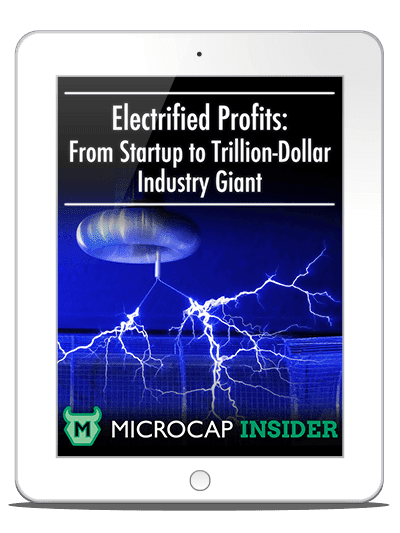
It's called “Electrified Profits: From Startup to Trillion-Dollar Industry Giant.”
I won't get into the full details right here because I'd like to send this report to you absolutely FREE of charge.
All you'll need to do is claim the report and it'll be yours… FREE.
The only thing I ask in exchange for this special report is that you take a test drive of Microcap Insider and see how you like it.
Once you do that, I'll send you the FREE report I just told you about, “Electrified Profits: From Startup to Trillion-Dollar Industry Giant,” and give you full membership privileges for the entire trial period…
It's the Best FREE Advice You'll Ever Get
As I've been saying from the start, this company is probably the most dramatic investment opportunity I've ever run across. And I fully plan to sit on my own position until I've seen at least four-figure gains.
What you do once you buy the shares is your decision.
My job is to give you the information and step back. And that lets you decide how much to invest and how much profit to bank.
But please understand: The subscription you can test-drive today will offer you far more than just the information on this stock.
With your risk-free trial subscription, you'll also receive…
- Weekly issues of Microcap Insider. You'll receive every copy by email, quickly and efficiently.
- Real-time buy and sell alerts. In this fast-moving market, opportune buy and sell points can come at any time. And I'll make sure that you receive them the moment they arrive.
- Specific entry, exit, and target prices. You'll never have to guess if a stock is a good buy or not. I'll always give you specific entry points, sell prices, and realistic targets for our recommendations.
- Complete research for every recommendation. You'll always know exactly why I recommend a stock. You'll know what catalysts to expect and what hurdles to watch out for. That way, you'll be able to invest and profit with confidence.
- Access to VIP service. A subscription to Microcap Insider qualifies you for VIP service. You can contact the VIP team with any questions at 844-310-4115.
That's a pretty full slate of benefits. And it's still not all…
Besides the special report that I've been talking about, “Electrified Profits: From Startup to Trillion-Dollar Industry Giant,” you'll also get these bonus reports to ensure that your ability to profit is constant and consistent:
- “Tesla 2.0: The Government-Mandated $7.5 Billion EV Revolution” — It flies under the radar, but this company is quietly, steadily taking over an entire segment of the transportation market while the rest of the industry is looking the other way. How is the company doing it? Here's a hint. It's thinking bigger than just your average everyday car on the road. Orders are coming in from all over North America, but I bet you've never heard of this stock. You will soon.
- “Penny Stock Quick-Start Guide” — Learn all the tricks and how to recognize all the pitfalls of the most lucrative kind of stock trading in existence with the “Penny Stock Quick-Start Guide.”

You'll also have access to all my archived reports. They detail more than a dozen little-known but rapid profit-generating investment ideas.
It's a lot of material. And it opens the doors to enormous opportunities.
Of course, I'm sure you're wondering by now how much it costs to become a member of Microcap Insider…
I know secrets and advice like this can go for a pretty penny in some circles.
In fact, I personally know of services that cost up to $5,000 per year for similar information.
And I could easily charge that much and sleep well at night. And it's because I'd know that a single investment could put 10 times that much into the pockets of my readers.
But I don't need to be greedy. I'd rather let this information reach as many people as possible than keep the secrets in the hands of the elite few who can afford such a cost.
So I decided on a price that's a mere fraction of that figure.
Today, you can receive an entire year of Microcap Insider for only $1,999.
That breaks down to about $5.47 a day.
It's the lowest price I could possibly think of charging. And it actually comes at a risk to me because I can't let too many people into this investment club without potentially affecting the share prices of our target stocks.
I consider that an absolute steal, because you could make that amount back with a single penny stock play…
So Try Me Out for 90 Days — No Pressure
If you don't like it, don't keep it. If you decide it's not for you within that three-month trial period, you'll be 100% covered by my no-risk guarantee.
During that time, you'll have full membership access. You can log in to the private members' site, check out all the special reports, and view every update I've posted.
If you find that Microcap Insider isn't what you thought, let me know. I'll refund every penny you've spent on the subscription — no questions asked.
Any information, reports, or profits that you received courtesy of my service will be yours to keep.
You won't find an opportunity like this anywhere else. And with the amount of information that I'll be giving you FREE of charge, taking a trial run of Microcap Insider is a no-brainer.
I'll be honest: I wish something like this had been available to me when I was starting out.
It would have given me a huge head start on building my own fortune.
So if making the investment of a lifetime is something you're ready to do, lock in your spot today.
The only drawback here is that for this particular stock, with the way things are progressing, there might not be a tomorrow.
Simply click the “Subscribe Now” button below to get started.
But please hurry…
Because if more than 1% of the people reading this invitation right now respond, I must take this presentation offline immediately.
As I said, we're dealing with the tiniest stocks on the market here.
Any big influx of readers can push up share prices and adversely affect everyone's profit potential.
So I really must limit Microcap Insider membership.
If you're late to respond to this invitation, your name will go on a waiting list with potentially thousands of other readers. And that's why I urge you to subscribe right now if this is something you're interested in.
It's easy to do.
Simply click the button below that says “Subscribe Now,” complete the secure invitation form, and you'll be in!
It takes only seconds.
Don't put off living the good life any longer than you already have. Click here to get started.
Sincerely,

Alex Koyfman
Founder and Investment Director, Microcap Insider
P.S. Because this company's stock is already poised to potentially skyrocket overnight, I urge you to respond right now, while it's on your mind. If you miss out on a one-day gain of 50%, 100%, or more, you'll kick yourself.
So click below to get started…
Angel Publishing LLC, a general interest newsletter is not liable for the suitability or future investment performance of any securities or strategies discussed. Please note that we are not a registered investment firm or broker/dealer. Only a registered broker or investment adviser may advise you individually on the suitability and performance of your portfolio or specific investments.
Readers are advised that the material contained herein should be used solely for informational purposes. As a publisher of a financial newsletter of general and regular circulation, we cannot tender individual investment advice. We urge you to always conduct your own research and due diligence and obtain professional advice before making any investment decision.
We will not be liable for any loss or damage caused by a reader's reliance on information obtained on our web sites. Our readers are solely responsible for their own investment decisions. Historical investment return examples given are hypothetical, and not to be taken as representative of any individual's actual trading experience. Please click here to see our Details and Disclosures

